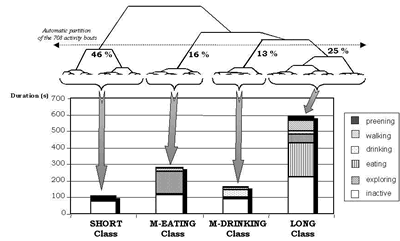Using
a classification of activity bouts to simplify observation in meat-type chickens
C. Bizeray, C. Leterrier
and J.M. Faure
Station
de Recherches Avicoles, I.N.R.A. Centre de Tours, Nouzilly, France
Introduction
A detailed focal sampling study of general activity in chickens is helpful to
establish the organisation of the different activities performed during the
time the chickens spend awake. However, such a recording is very time consuming
and difficult to practice in commercial conditions where chickens can not be
followed with one's eyes for a long time. The aim of the study was to find out
the way several behavioural patterns are organised and to elaborate a simplified
method of observation.
Methods
Twenty five broiler chickens were videotaped and observed for one hour per day
at 1, 2, 3 and 5 weeks of age using The
Observer 3.0. All behaviour patterns expressed when birds were awake were
recorded as "activity bouts" (i.e. from the moment a bird stood up until it
remained idle for at least 30 s). The 708 activity bouts recorded were analysed
by Principal Component Analysis followed by an automatic procedure of partitioning,
defining several classes of bouts.
Results
- Four different classes
of activity bouts were obtained by the classification (Figure 1) and differed
highly in the mean duration of the bout: SHORT (78 s), M-EATING (M = Medium,
252 s), M-DRINKING (134 s) and LONG (559 s) classes. The bouts of the 4 classes
also differed in their occurrence (46%, 16%, 13% and 25% of the bouts, respectively)
and in their level of activity (duration of walking per bout: 4 s, 15 s, 14
s, 66 s, respectively). The SHORT class contained short bouts with low activity
and mobility, but many preening per iods. The M-EATING and M-DRINKING classes
contained bouts in which eating or drinking activi ties, respectively, contributed
to the major part of the activity. The LONG class contained long-lasting bouts
(almost 10 min), with high levels of activity, especially locomotion and exploration.
- Age did not significantly
affect the SHORT class. There was a large decrease in the occurrence and in
the duration of the LONG class bouts throughout the life-span, whereas M-EATING
and M-DRINKING classes bouts became more numerous as chicks grew up and represented
the major part of the activity at the end of the growing period.
- A simplified method
using bout duration and the first 2 behavioural patterns occurring within
the 3 first minutes allowed to predict the class into which each bout would
fall with 76.8% accuracy.

Figure
1. Mean duration(s) of the behavioral patterns and total bouts duration
in each class.
Conclusions
- The activity bouts
could be categorised into four classes, which differ highly in occurrence,
duration and composition.
- The LONG class contained
bouts with high levels of locomotion and exploration. Their occurrence could
be used as an indicator of general activity throughout the lifespan.
- The relationship
between the beginning of the activity bout and the entire activity suggests
that the type of activity (composition and duration) performed by a chick
is planned as soon as it stands up.
- These results could
be used in order to simplify the observation, and to decrease the time spent
quantifying the behaviour of chickens.
Poster presented at Measuring
Behavior 2000, 3rd International Conference on Methods and
Techniques in Behavioral Research, 15-18 August 2000, Nijmegen, The Netherlands
© 2000 Noldus
Information Technology b.v.

